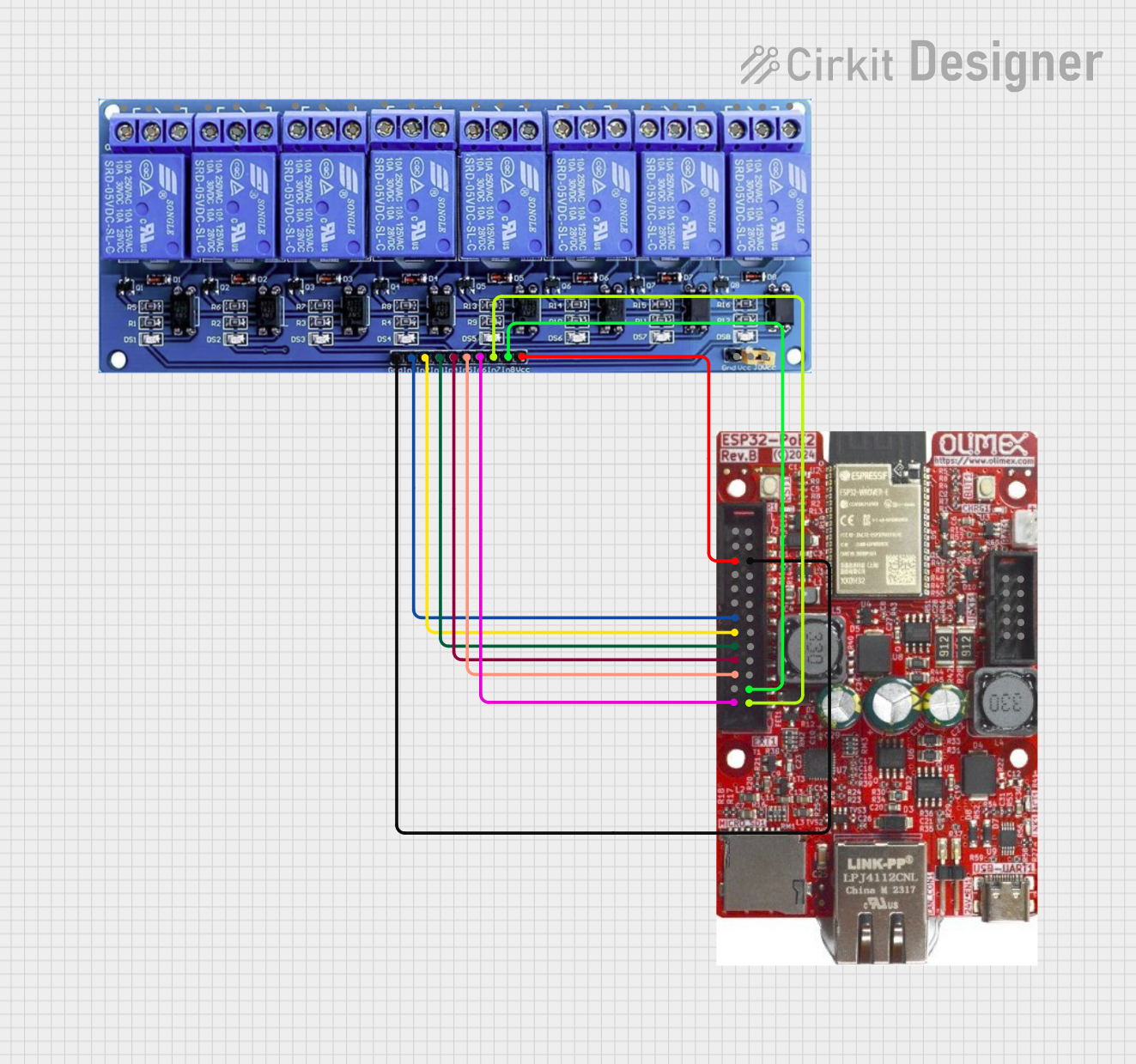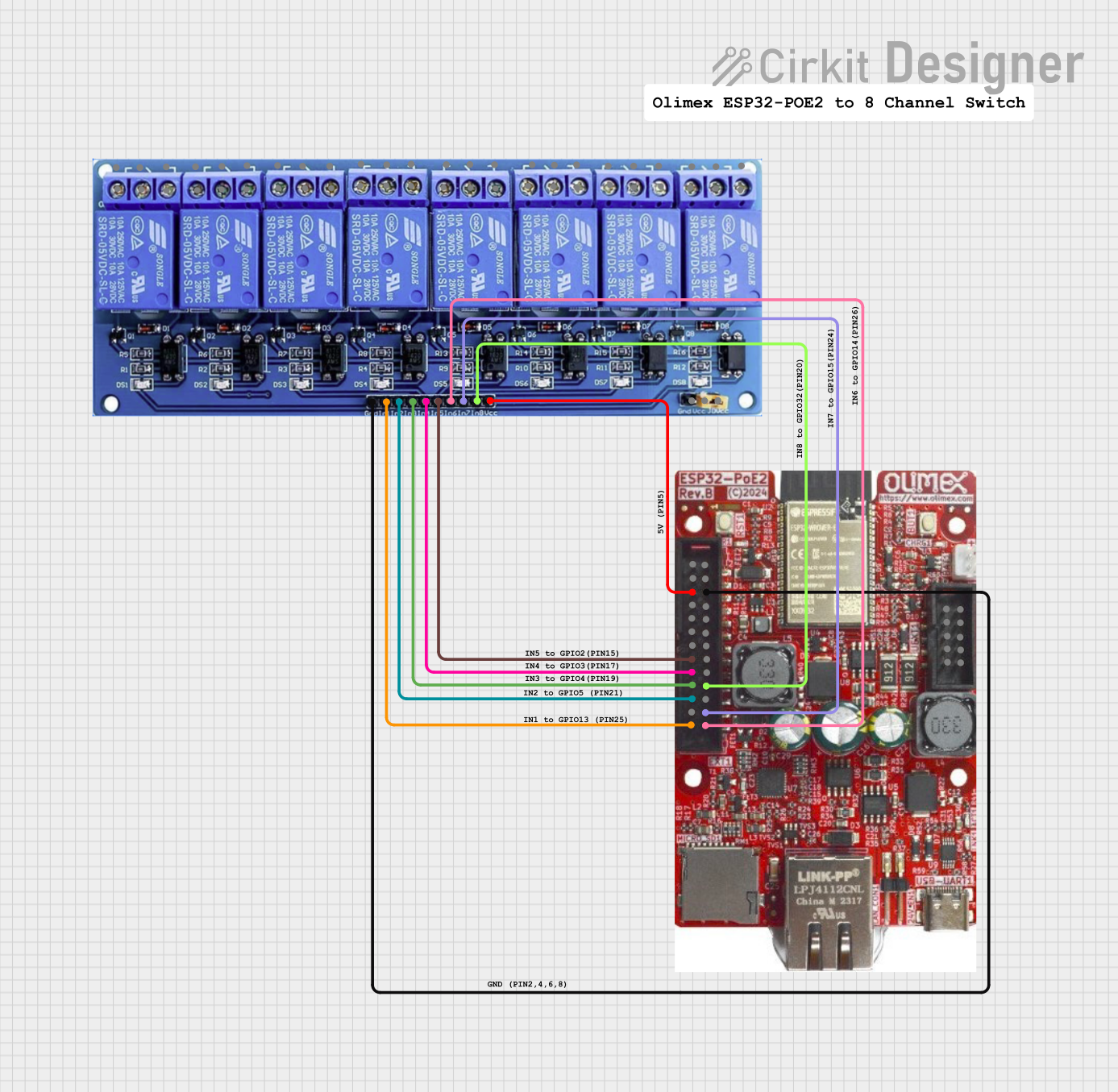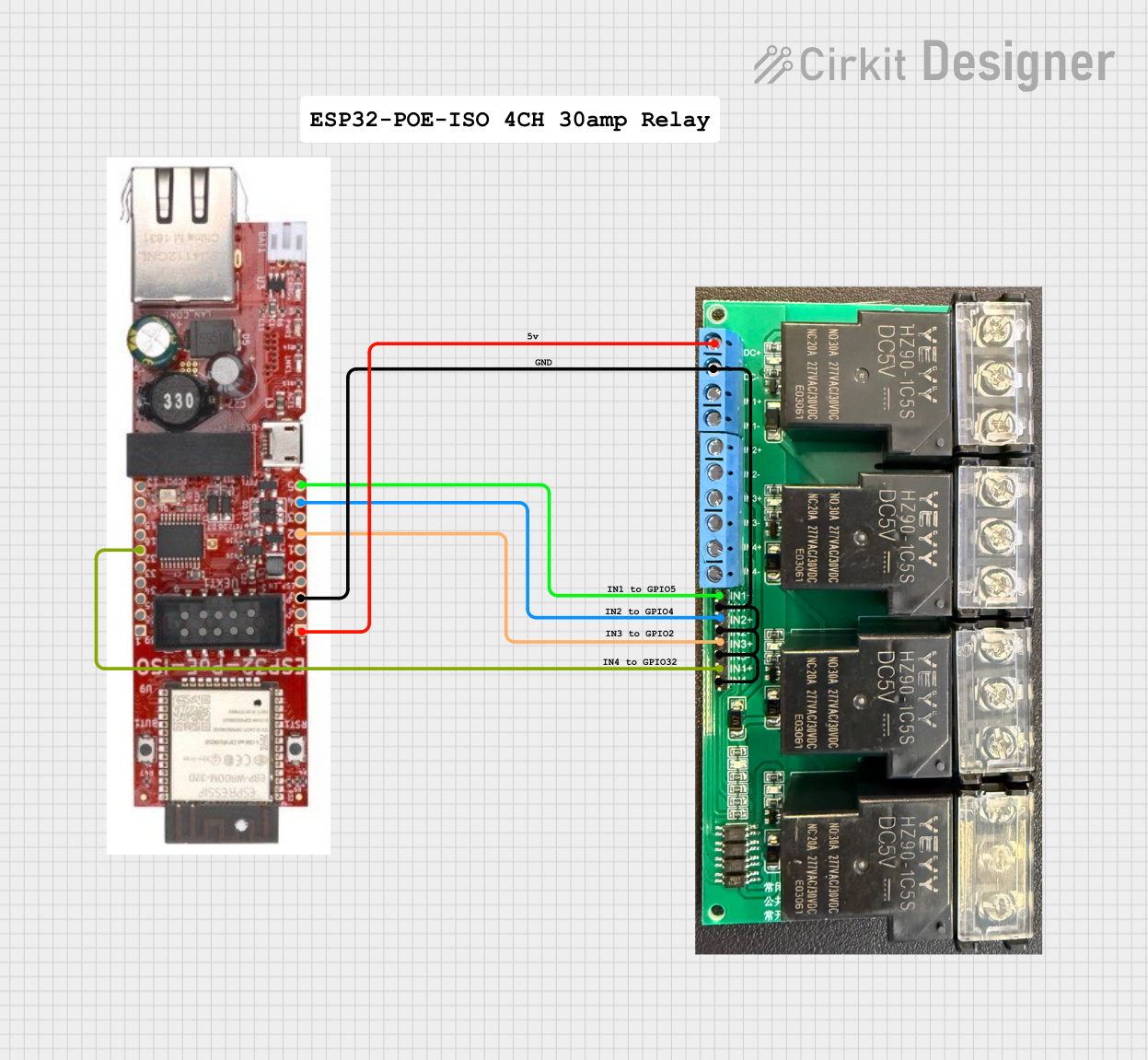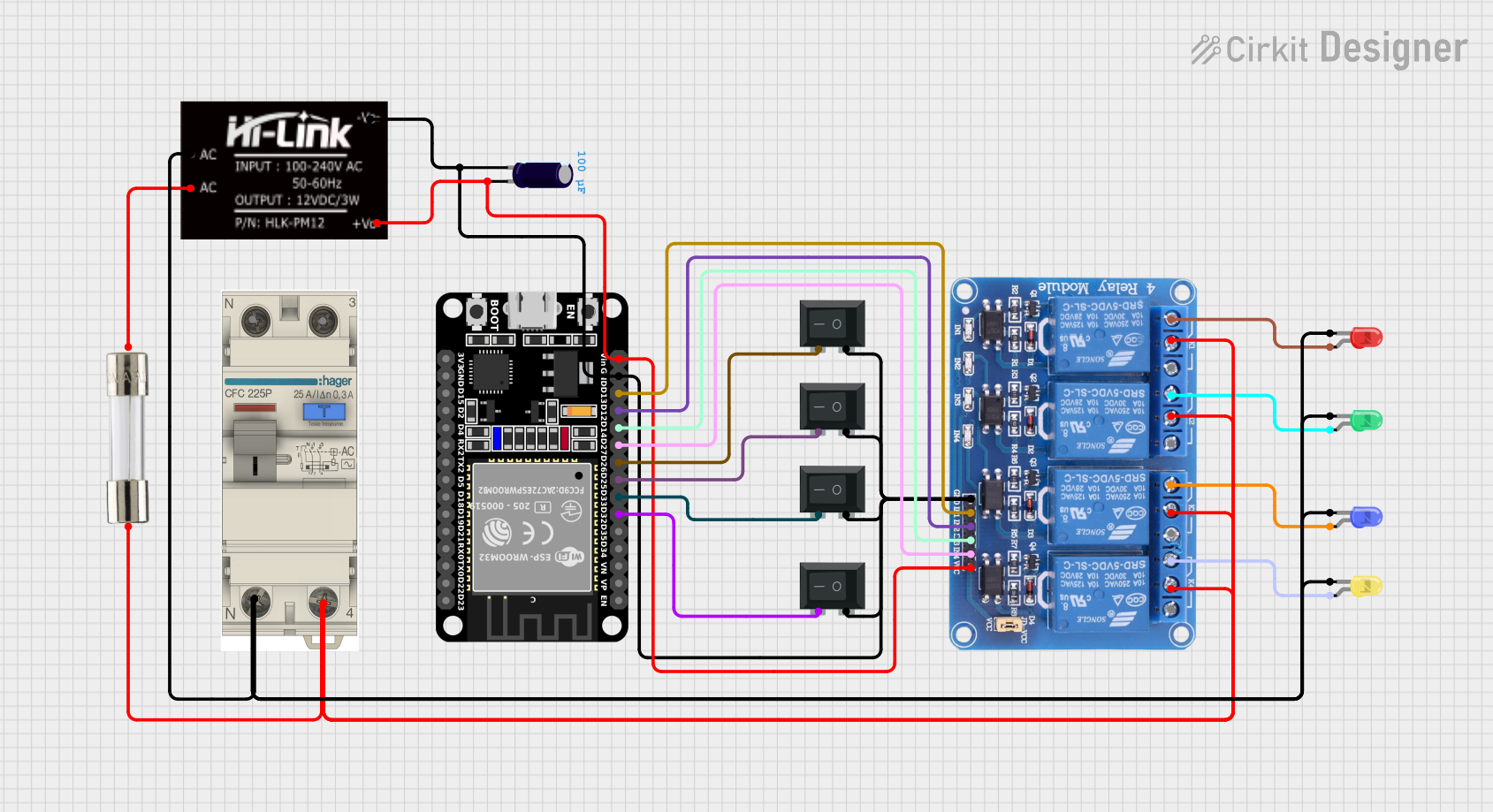
How to Use One Channel Relay with Optocoupler: Examples, Pinouts, and Specs

 Design with One Channel Relay with Optocoupler in Cirkit Designer
Design with One Channel Relay with Optocoupler in Cirkit DesignerIntroduction
The One Channel Relay with Optocoupler is an electronic switching device that allows a low-power control signal to operate a high-power circuit. It features an optocoupler, which provides electrical isolation between the control side (low voltage) and the load side (high voltage). This isolation enhances safety and prevents damage to sensitive control circuits.
Explore Projects Built with One Channel Relay with Optocoupler

 Open Project in Cirkit Designer
Open Project in Cirkit Designer
 Open Project in Cirkit Designer
Open Project in Cirkit Designer
 Open Project in Cirkit Designer
Open Project in Cirkit Designer
 Open Project in Cirkit Designer
Open Project in Cirkit DesignerExplore Projects Built with One Channel Relay with Optocoupler

 Open Project in Cirkit Designer
Open Project in Cirkit Designer
 Open Project in Cirkit Designer
Open Project in Cirkit Designer
 Open Project in Cirkit Designer
Open Project in Cirkit Designer
 Open Project in Cirkit Designer
Open Project in Cirkit DesignerCommon Applications and Use Cases
- Home automation systems (e.g., controlling lights, fans, or appliances)
- Industrial control systems
- Motor control
- IoT projects
- Arduino and microcontroller-based projects
Technical Specifications
The following table outlines the key technical details of the One Channel Relay with Optocoupler:
| Parameter | Value |
|---|---|
| Operating Voltage | 5V DC |
| Trigger Voltage | 3.3V to 5V DC |
| Maximum Load Voltage | 250V AC / 30V DC |
| Maximum Load Current | 10A |
| Isolation Method | Optocoupler |
| Relay Type | SPDT (Single Pole Double Throw) |
| Dimensions | ~50mm x 26mm x 18mm |
| Indicator LED | Yes (indicates relay activation) |
Pin Configuration and Descriptions
The One Channel Relay with Optocoupler typically has the following pin configuration:
Control Side (Low Voltage)
| Pin Name | Description |
|---|---|
| VCC | Connect to the 5V power supply. |
| GND | Connect to the ground of the power supply. |
| IN | Control signal input. A HIGH signal activates the relay. |
Load Side (High Voltage)
| Terminal Name | Description |
|---|---|
| COM | Common terminal. Connect to the load or power source. |
| NO | Normally Open terminal. Connect to the load for default OFF state. |
| NC | Normally Closed terminal. Connect to the load for default ON state. |
Usage Instructions
How to Use the Component in a Circuit
- Power the Relay Module: Connect the VCC pin to a 5V DC power source and the GND pin to ground.
- Control Signal: Connect the IN pin to a microcontroller (e.g., Arduino) or any other control circuit capable of providing a 3.3V to 5V signal.
- Load Connection:
- Connect the power source for the load to the COM terminal.
- Connect the load to either the NO (Normally Open) or NC (Normally Closed) terminal, depending on the desired default state:
- Use NO if the load should be OFF by default and turn ON when the relay is activated.
- Use NC if the load should be ON by default and turn OFF when the relay is activated.
- Control the Relay: Send a HIGH signal (3.3V to 5V) to the IN pin to activate the relay and switch the load.
Important Considerations and Best Practices
- Electrical Isolation: The optocoupler ensures isolation between the control and load sides. However, ensure proper grounding to avoid noise or interference.
- Load Ratings: Do not exceed the maximum voltage (250V AC / 30V DC) or current (10A) ratings of the relay.
- Flyback Diode: If controlling an inductive load (e.g., motor, solenoid), use a flyback diode across the load to protect the relay from voltage spikes.
- Indicator LED: Use the onboard LED as a visual indicator to confirm relay activation.
Example: Connecting to an Arduino UNO
Below is an example of how to connect and control the relay using an Arduino UNO:
Circuit Connections
- Relay Module:
- VCC → 5V pin on Arduino
- GND → GND pin on Arduino
- IN → Digital pin 7 on Arduino
- Load:
- COM → Live wire of the power source
- NO → One terminal of the load
- Neutral wire → Other terminal of the load
Arduino Code
// Define the relay control pin
const int relayPin = 7;
void setup() {
// Set the relay pin as an output
pinMode(relayPin, OUTPUT);
// Ensure the relay is off at startup
digitalWrite(relayPin, LOW);
}
void loop() {
// Turn the relay ON
digitalWrite(relayPin, HIGH);
delay(5000); // Keep the relay ON for 5 seconds
// Turn the relay OFF
digitalWrite(relayPin, LOW);
delay(5000); // Keep the relay OFF for 5 seconds
}
Troubleshooting and FAQs
Common Issues and Solutions
Relay Not Activating:
- Cause: Insufficient control signal voltage.
- Solution: Ensure the IN pin receives a HIGH signal (3.3V to 5V). Check the microcontroller's output voltage.
Load Not Switching:
- Cause: Incorrect wiring of the load terminals.
- Solution: Verify the connections to the COM, NO, and NC terminals. Ensure the load is connected properly.
Relay Stuck in One State:
- Cause: Damaged relay or excessive load current.
- Solution: Check the load's current and voltage ratings. Replace the relay if necessary.
Indicator LED Not Lighting Up:
- Cause: No power to the relay module.
- Solution: Ensure the VCC and GND pins are properly connected to a 5V power source.
FAQs
Can I use this relay with a 3.3V microcontroller?
- Yes, the relay can be triggered with a 3.3V control signal, but ensure the VCC pin is powered with 5V.
Is the relay safe for high-power applications?
- Yes, as long as the load does not exceed the maximum ratings (250V AC / 30V DC, 10A).
Can I control multiple relays with one Arduino?
- Yes, you can control multiple relays by connecting their IN pins to different digital pins on the Arduino.
What is the purpose of the optocoupler?
- The optocoupler provides electrical isolation between the control and load sides, protecting the control circuit from high-voltage spikes or surges.